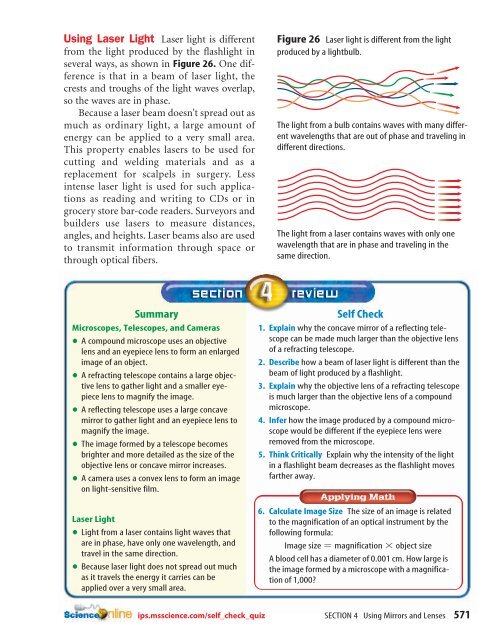Light Mirrors and Lenses (3379.0K) - McGraw-Hill Higher Education
Light Mirrors and Lenses (3379.0K) - McGraw-Hill Higher Education
Light Mirrors and Lenses (3379.0K) - McGraw-Hill Higher Education
- No tags were found...
Create successful ePaper yourself
Turn your PDF publications into a flip-book with our unique Google optimized e-Paper software.
Using Laser <strong>Light</strong> Laser light is differentfrom the light produced by the flashlight inseveral ways, as shown in Figure 26. One differenceis that in a beam of laser light, thecrests <strong>and</strong> troughs of the light waves overlap,so the waves are in phase.Because a laser beam doesn’t spread out asmuch as ordinary light, a large amount ofenergy can be applied to a very small area.This property enables lasers to be used forcutting <strong>and</strong> welding materials <strong>and</strong> as areplacement for scalpels in surgery. Lessintense laser light is used for such applicationsas reading <strong>and</strong> writing to CDs or ingrocery store bar-code readers. Surveyors <strong>and</strong>builders use lasers to measure distances,angles, <strong>and</strong> heights. Laser beams also are usedto transmit information through space orthrough optical fibers.Figure 26 Laser light is different from the lightproduced by a lightbulb.The light from a bulb contains waves with many differentwavelengths that are out of phase <strong>and</strong> traveling indifferent directions.The light from a laser contains waves with only onewavelength that are in phase <strong>and</strong> traveling in thesame direction.SummaryMicroscopes,•Telescopes, <strong>and</strong> CamerasA compound microscope uses an objectivelens <strong>and</strong> an eyepiece lens to form an enlarged•image of an object.A refracting telescope contains a large objectivelens to gather light <strong>and</strong> a smaller eyepiecelens to magnify the image.•A reflecting telescope uses a large concavemirror to gather light <strong>and</strong> an eyepiece lens to•magnify the image.The image formed by a telescope becomesbrighter <strong>and</strong> more detailed as the size of the•objective lens or concave mirror increases.A camera uses a convex lens to form an imageon light-sensitive film.•Laser <strong>Light</strong><strong>Light</strong> from a laser contains light waves thatare in phase, have only one wavelength, <strong>and</strong>•travel in the same direction.Because laser light does not spread out muchas it travels the energy it carries can beapplied over a very small area.Self Check1. Explain why the concave mirror of a reflecting telescopecan be made much larger than the objective lensof a refracting telescope.2. Describe how a beam of laser light is different than thebeam of light produced by a flashlight.3. Explain why the objective lens of a refracting telescopeis much larger than the objective lens of a compoundmicroscope.4. Infer how the image produced by a compound microscopewould be different if the eyepiece lens wereremoved from the microscope.5. Think Critically Explain why the intensity of the lightin a flashlight beam decreases as the flashlight movesfarther away.6. Calculate Image Size The size of an image is relatedto the magnification of an optical instrument by thefollowing formula:Image size magnification object sizeA blood cell has a diameter of 0.001 cm. How large isthe image formed by a microscope with a magnificationof 1,000?ips.msscience.com/self_check_quizSECTION 4 Using <strong>Mirrors</strong> <strong>and</strong> <strong>Lenses</strong> 571

















